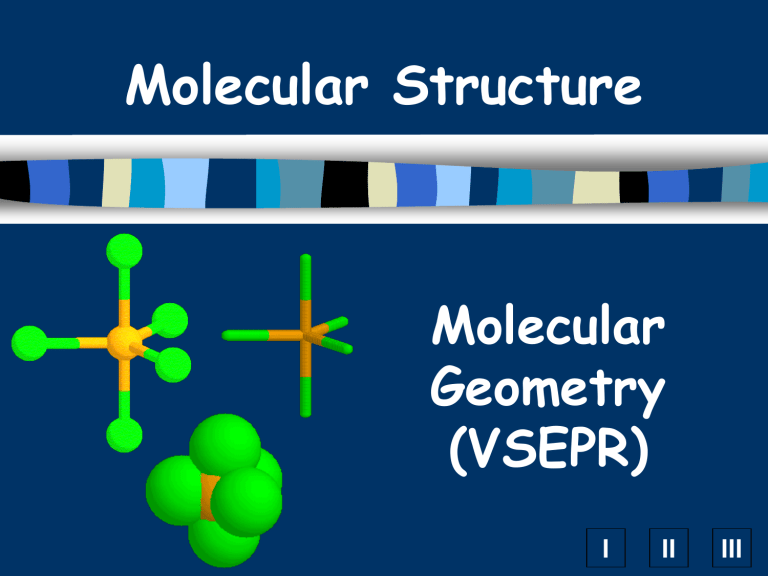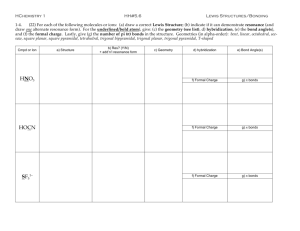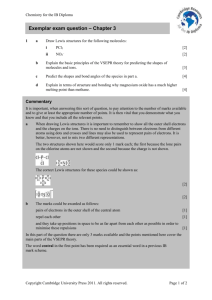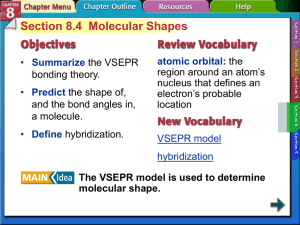vsepr

Molecular Structure
Molecular
Geometry
(VSEPR)
III
YouTube
Video on VSPER Theory
Learning Objectives
TLW predict molecular structure for molecules using Valence Shell Electron
Pair Repulsion (VSEPR) Theory (TEKS
7.E)
A. VSEPR Theory
1. V alence S hell E lectron P air R epulsion
Theory gives us a three-dimensional picture of atomic bonding that the
Electron Dot Structure does not.
2. Electron pairs orient themselves in order to minimize repulsive forces.
VSEPR:
3. Predicts three dimensional geometry of molecules.
4. The name tells you the theory:
5. Valence shell - outside electrons.
6. Electron Pair repulsion - electron pairs try to get as far away as possible.
7. Can determine the angles of bonds.
A. VSEPR Theory
Types of e Pairs
1. Bonding pairs - form bonds
2. Lone pairs - nonbonding e -
Lone pairs repel more strongly than bonding pairs!!!
A. VSEPR Theory
Lone pairs reduce the bond angle between atoms.
Bond Angle
B. Determining Molecular Shape
1. Draw the Lewis Diagram.
2. Tally up e pairs on central atom.
a. double/triple bonds = ONE pair
3. Shape is determined by the # of bonding pairs and lone pairs.
Know the 3 most common shapes
& their bond angles!
C. Common Molecular Shapes 1
2 total
2 bond
0 lone
BeH
2
LINEAR
180 °
Examples
CO
2
2 total
2 bond
0 lone
O C O
LINEAR
180 °
C. Common Molecular Shapes 2
3 total
2 bond
1 lone
SO
2 BENT
<120 °
C. Common Molecular Shapes 3
3 total
3 bond
0 lone
BF
3
TRIGONAL PLANAR
120 °
C. Common Molecular Shapes 4
4 total
4 bond
0 lone
CH
4
TETRAHEDRAL
109.5
°
C. Common Molecular Shapes 5
4 total
3 bond
1 lone
NH
3
TRIGONAL PYRAMIDAL
107 °
Examples
PF
3
4 total
3 bond
1 lone
F P F
F
TRIGONAL
PYRAMIDAL
107 °
C. Common Molecular Shapes 6
4 total
2 bond
2 lone
H
2
O
BENT
104.5
°
C. Common Molecular Shapes 7
5 total
5 bond
0 lone
PCl
5
TRIGONAL
BIPYRAMIDAL
120 °/90°
C. Common Molecular Shapes 8
6 total
6 bond
0 lone
SF
6
OCTAHEDRAL
90 °
Examples
linear: BeH
2
, CO
2
, MgF
2
, I
3 bent (angular): SO
2
, H
2
O, H square planar: XeF
4
, IF
4
-
2
S, SF
2 trigonal planar : SO
3
, BF
3 square pyramidal: IF
5
, BrF
5 trigonal pyramidal: NH
3
, PF
3
, AsCl
3 trigonal bipyramidal: PF
5
, PCl
5
, AsF tetrahedral : CH
4
, CF
4
, SO
4
2-
5 octahedral: SF
6
, PF
6
, SiF
6
2seesaw: SF
4
T-shaped: ClF
3
D. Orbital Hybridization
VSEPR Theory works well when accounting for molecular shapes, but doesn’t help describing the types of bonds formed.
In hybridization, several atomic orbitals mix to form the same total number of equivalent hybrid orbitals
YouTube video
D. Orbital Hybridization
For Example ~ Methane (CH
4
)
C = 1s 2 2s 2 2p 2
H = 1s 1 (and there are four H atoms)
C re-configures its one 2s and three 2p orbitals into four sp 3 orbitals, which overlap the 1s orbitals of the 4 hydrogen atoms
Group Practice
Molecular Geometry Construction
Game Revisited
E. One Other Note on Bonding
Electronegativity determines bonding which contributes to the bond angle
Greater than 1.7 ionic bonds
0.3 – 1.7 polar covalent bonds
0 – 0.3 covalent
See handout for trends through periodic table
Electronegativities
•
Greater than 1.7
ionic bonds
•
0.3 – 1.7
polar covalent bonds
•
0 – 0.3
covalent
Independent Practice
Building 3-D Examples of Molecular
Geometry
VSEPR Marshmellow Lab
VSEPR Exercise – 2






